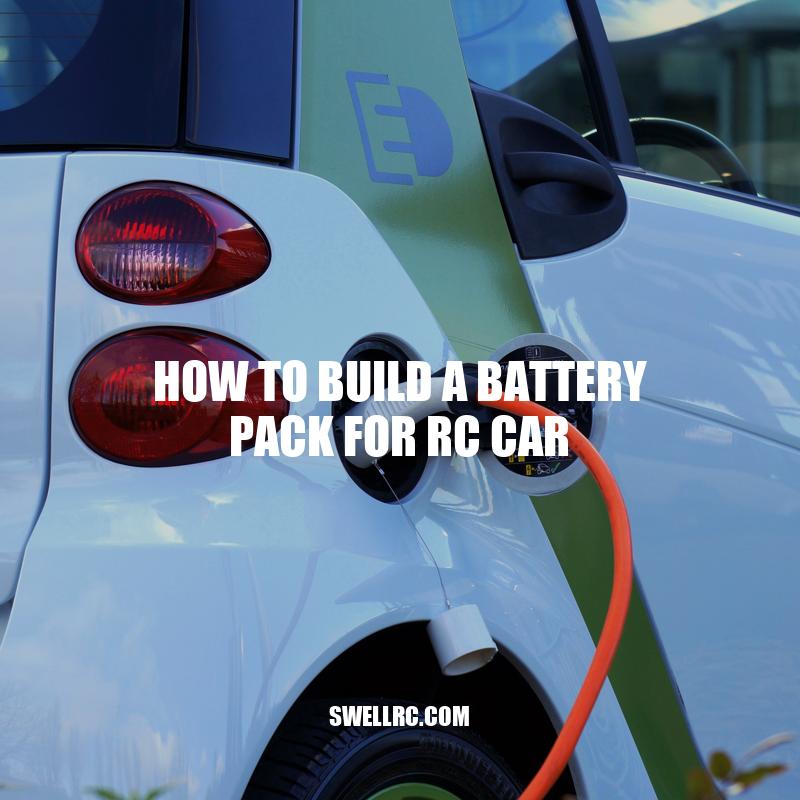DIY: Building a Custom Battery Pack for Your RC Car
Building a battery pack for an RC car is a great way to customize your RC car’s performance and extend its runtime. RC car enthusiasts prefer customized battery packs because they provide more power and are more reliable than standard store-bought ones. Despite the initial expense of buying the necessary equipment and battery cells, crafting your battery pack will save you money in the long run because you can replace a faulty cell instead of purchasing a new battery pack altogether. Moreover, building a battery pack for your RC car is an exciting and fulfilling activity that enables you to apply your technical skills while enhancing your RC car’s performance. In this article, we’ll go through the steps involved in building a battery pack for your RC car, highlighting the materials required, how to connect the cells, how to add the connector and how to test it once assembled. By the end of this guide, you will have the knowledge you need to build a customized battery pack for your RC car that will provide better performance, longer runtime and an improved overall driving experience.
Materials Required
To build a battery pack for your RC car, you’ll need the following materials:
- Battery holder
- Connector
- Soldering iron
- Solder
- Wire strippers
- Rechargeable battery cells (such as LiPo or Li-ion)
These materials are available at any electronics store or online. Some websites that offer these materials include Amazon, eBay, AliExpress, and HobbyKing. Make sure that you choose high-quality materials, especially for the battery cells, connectors and holder. Poor quality components will negatively affect the performance of your battery pack and RC car. Additionally, ensure that you have the right sizes and ratings of the materials, depending on your RC car’s voltage and capacity requirements.
What does a battery pack do?
A battery pack is a collection of individual batteries connected together to create a single source of power. Here are a few things a battery pack can do:
- Provide portable power for your electronic devices
- Store energy from renewable sources, like solar panels or wind turbines
- Power electric vehicles or other machinery
If you’re interested in learning more about battery packs, you can find a wide variety of them on websites like Amazon or Best Buy.
Choosing Battery Cells
When building a battery pack for your RC car, it’s essential to choose the right battery cells. Here are some factors to consider:
- Voltage: RC cars usually require a specific voltage rating, which means that you need to choose battery cells that can deliver the required voltage when connected in series (positive to negative).
- Capacity: The capacity of a battery cell determines how long it will last before it needs to be recharged. Higher capacity cells will last longer, but they may also be bulkier or heavier.
- Weight: The weight of the battery pack can affect the performance of your RC car. Heavy battery packs can slow down your car, while lighter battery packs can make it faster and more agile.
- Quality: Choosing high-quality battery cells is important to ensure that the battery pack is safe and reliable.
Some popular battery cell brands for RC cars include Turnigy, Gens Ace, Tattu, and Venom. Make sure to verify the specifications and ratings of the battery cells before you purchase them.
Battery Cells Comparison Table
| Brand | Voltage | Capacity | Weight | Price |
|---|---|---|---|---|
| Turnigy | 3.7V-11.1V | 800mAh-5000mAh | 30g-350g | $8.99-$59.99 |
| Gens Ace | 7.4V-22.2V | 2200mAh-8200mAh | 100g-LLT | $14.99-$89.99 |
| Tattu | 7.4V-22.2V | 450mAh-8000mAh | 20g-705g | $12.99-$139.99 |
| Venom | 7.4V-11.1V | 1300mAh-5500mAh | 60g-272g | $14.99-$54.99 |
What battery can I use in my RC car?
When it comes to choosing a battery for your RC car, there are a few factors to consider such as the battery chemistry, capacity and voltage. Here are some options:
- LiPo (Lithium Polymer) battery: these have become popular due to their high energy density and low weight, making them a great choice for racing drones and electric RC cars. They can be found in various capacities and voltage ratings, but it’s important to always use a charger and discharge balancer specifically designed for LiPo batteries to ensure safe handling.
- NiMH (Nickel-Metal Hydride) battery: these are a more affordable option and are widely used in beginner-level RC cars. They offer a decent capacity and can be charged with a standard NiMH battery charger.
- NiCad (Nickel-Cadmium) battery: this used to be a popular choice, but due to their lower energy density and environmental concerns they are being phased out in favor of newer battery chemistries like LiPo and NiMH.
Remember to always check the manufacturer’s recommendations for your specific RC car model and avoid using incompatible batteries as this could damage your vehicle or worse.
For more information on RC car batteries and chargers, check out websites like Hobbyking.com or Traxxas.com.
Connecting the Battery Cells
Connecting the battery cells is a critical step in building the battery pack for your RC car. It’s essential to follow the correct sequence and ensure a good connection to avoid safety hazards like short circuits, battery explosions, and fires. Here are the steps to follow:
- Use a battery holder or a jig to hold the battery cells in place while you work on them.
- Using a wire stripper, strip about ¼ inch of insulation off the end of the battery cell wires.
- Solder the wires to the battery terminals in the correct sequence following the battery pack’s required voltage and capacity.
- Connect the positive wire of the first battery cell to the negative wire of the second battery cell, and so on, until you connect all the cells according to the voltage and capacity you need.
- Use heat shrink tubing or electrical tape to cover the exposed wires and prevent short circuits.
To learn more about connecting battery cells, you can watch tutorials online or seek guidance from experts in the RC community. Remember to use the correct equipment and follow safety precautions when working with batteries.
Websites for Battery Pack Parts:
- HobbyKing
- Amazon
- Banggood
- Tower Hobbies
How should the batteries be connected?
When connecting batteries, it’s important to follow a specific order to ensure safe and proper operation of your electrical system. Here are some steps to follow:
- Connect the negative (-) cable of the first battery to the vehicle’s frame or grounding point.
- Connect the positive (+) cable of the first battery to the negative (-) terminal of the second battery.
- Connect the positive (+) cable of the second battery to the starter or power distribution point of the vehicle.
It’s also important to use the correct size cables and fuses as recommended by the battery and vehicle manufacturer. Make sure to regularly check the battery connections for signs of corrosion or loose connections.
If you need more information about connecting batteries, you can visit websites like Battery University or contact your battery supplier for guidance.
Adding the Connector
After you have connected the battery cells, it’s time to add the connector. A connector allows you to charge the battery pack and connect it to your RC car. Here’s how to add a connector to your battery pack:
- Choose the type of connector that’s compatible with your RC car and battery holder.
- Cut the connector to the right length and strip about 1/8 inch of insulation from the wire ends.
- Solder the negative wire to the battery’s negative terminal and the positive wire to the positive terminal.
- Attach the connector to the battery holder using adhesive or tape.
There are various types of connectors available in the market, including Deans, Traxxas, XT60, and EC3. Ensure you pick the right connector based on your RC car and battery holder. Also, ensure that your connector can handle the current you need to run your RC car.
Websites for Connectors:
- Horizon Hobby
- Amain Hobbies
- Motion RC
How do you hook up a battery to a RC car?
To hook up a battery to an RC car, follow these steps:
- 1. Identify the positive and negative terminals on both the battery and the RC car.
- 2. Connect a battery connector to the battery’s positive and negative terminals.
- 3. Connect the other end of the battery connector to the RC car’s positive and negative terminals, respectively.
- 4. Secure the battery in place with a battery strap or other device.
If you need more detailed instructions or guidance, check out RC car manufacturer websites or hobbyist forums for tips and advice. You can also find instructional videos on YouTube or products like the Traxxas Battery and Charger Completer Pack that come with everything you need to get started.
Testing the Battery Pack
Before you finalize everything, you need to test the battery pack to ensure that it has the right voltage and capacity. Follow these steps to test the battery pack:
- Use a voltmeter to check the voltage of each cell, and ensure they are balanced.
- Calculate the pack’s total voltage and capacity using the values of each cell.
- Charge the battery pack fully and test it with the voltmeter to ensure the voltage and capacity is correct.
- Attach the battery pack to your RC car and test it to ensure it is working and delivers the required power.
It’s crucial to ensure that the battery pack has the correct voltage and capacity, and it’s working correctly before using it with your RC car.
Websites for Voltmeters:
- Amazon.com
- Harbor Freight
- Digi-Key Electronics
How are battery packs tested?
Here are some of the methods used to test battery packs:
- Charge and discharge tests
- Capacity tests
- Performance tests under different load conditions
- Temperature tests to check for safety and stability
- Cycle life tests to determine longevity
Battery pack testing is important to ensure that they are safe, reliable and perform at the level they are intended to. Some reputable websites that offer battery testing services include Intertek and UL.
Conclusion
Building a battery pack for an RC car is a fantastic way to improve its performance and extend its runtime. Knowing how to create the battery pack yourself can save you money as well. However, building a battery pack requires safety precautions, and you should ensure that you understand how to use the tools safely.
When building the battery pack, make sure to purchase high-quality batteries, be cautious when soldering, and verify the voltage and capacity measures with a voltmeter before using it. Always follow safety precautions and seek professional assistance if unsure.
By following the steps provided in this article and exercising safety measures, you can successfully create a battery pack that meets the specific needs of your RC car. Enjoy extended playtime with a higher level of performance by implementing these techniques.
Recommended Resources
Here are some additional resources that might be useful if you want to learn more about building battery packs for RC cars:
- Instructables: Step-by-step guide on building a Lithium Polymer battery pack for RC cars.
- YouTube Tutorials: Video tutorials that demonstrate how to build a battery pack that’s customized to your RC car’s specifications.
- RC Universe: Comprehensive article with a detailed breakdown of building an LI-ion battery pack for RC cars.



